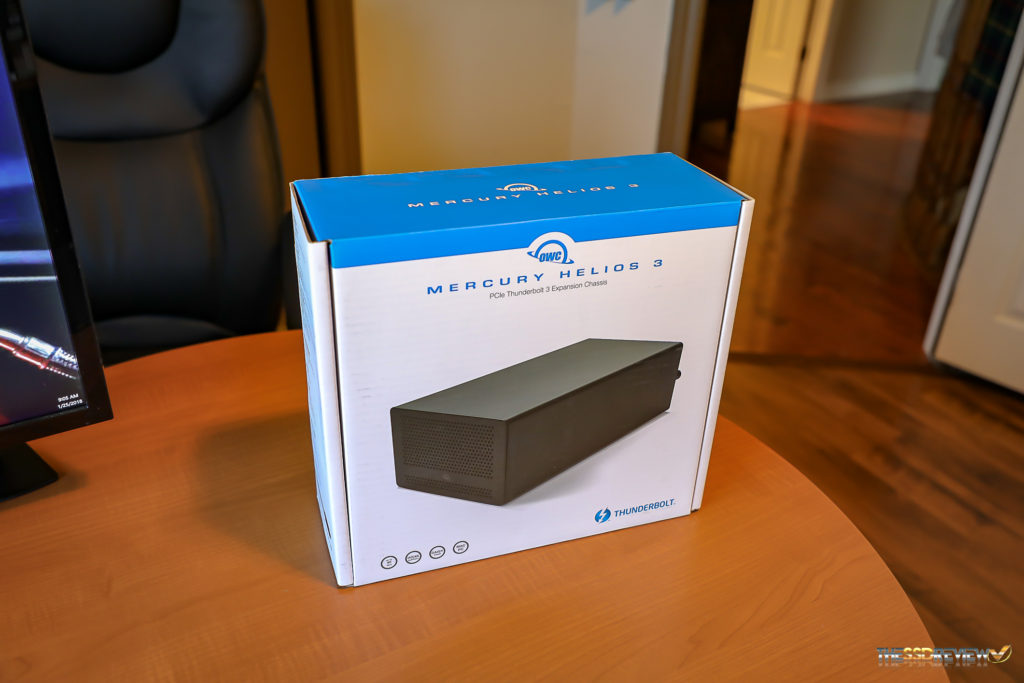For a media professional, data transfer is everything. The faster one can move and manipulate media, the more efficient the machine becomes. We take it for granted really but the massive work to perfect everything you watch on TV is incredible… and the ability to move media quickly is central to efficiency. This is where Thunderbolt 3 comes in. TB3 increases data transmission to 40Gbps which is 5GB/s theoretically, but breaks down to a maximum of about 2.8GB/s in reality.
Where we use to have simple HD files, they have grown to 4K, 5K and now 8K and media of that resolution simply cannot be run through a USB. The trick…is Thunderbolt 3 and the external devices companies envision to solve this speed and data storage problem. This is where the OWC Mercury Helios 3 PCIe Thunderbolt 3 Expansion Chassis comes in.
The OWC Mercury Helios 3 PCIe Thunderbolt 3 Expansion Chassis is an external PCIe add-in card (AIC) storage device that routes data through a TB3 cable and to or from your Mac or PC system. It accepts a half-height, full length, double width PCIe 3.0x 16 card and is backward compatible to PCIe 2/1 cards. In the box, one will find the Mercury Helios 3, a .5m TB3 cable, power adapter and instructions.
Understanding Thunderbolt 3 cables is critical to understanding data transfer speeds. With Thunderbolt 3, there are passive and active cables. A passive cable ‘up to’ .5m in length will provide the standard 40Gbps transfer rate without difficulty, but anything longer will cut that to 20Gbps speed of thunderbolt 2. You can get a longer cable (up to 6ft) to maintain your 40Gbps and this is termed as an active cable and just a bit more expensive than the standard included passive cable. Check out pricing at Amazon. but be sure to recognize the difference between passive (.5m/3.3ft) and active (1m/6.6ft) as I am sure you don’t want to purchase a cheaper 6ft TB3 cable that will leave you with only TB2 speeds.
The front of the OWC Mercury Helios 3 is of a very attractive and simple design with venting to allow for smooth air travel as this unit has a fan for active cooling. Although it cannot be seen in this picture, there is also a LED that lights during disk activity just below the OWC branding.
On the rear of the case, there are two spring screws on either side, power port, Display and two Thunderbolt 3 ports. For display, this device supports up to dual display configurations with up to 4K@60Hz for a single display, or 1080P@60HZ for dual. Of course the dual TB3 ports allow for daisy chaining of TB3 devices. We really have to compliment OWC on integration of spring screws that always stay in place as these do.
The OWC Mercury Helios 3 Thunderbolt 3 Expansion Chassis is available at Amazon or at OWC for $199 and comes with a 3-year limited warranty.
For our testing today, we will be using the worlds fastest enterprise NVMe SSD, the Kingston DCP1000 1.4TB SSD. We have tested this card to no end, and have published our enterprise report, enthusiast report as well as RAIDing two DCP1000’s for a a high throughput of 14GB/s and 2 million IOPS. Our testing today will be interesting though, and not just because we are going to test just how high Thunderbolt 3 can transfer data at its peak. The DCP1000 is based on four Kingston KC1000 M.2 NVMe SSDs and our scenario will see each as a logical drive in the OS where they will be tested through the system softRAID in RAID 0.
 The SSD Review The Worlds Dedicated SSD Education and Review Resource |
The SSD Review The Worlds Dedicated SSD Education and Review Resource | 


Could you use an Asus Hyper M.2 X16 Card with 4 NVMe sticks, possibly double that and scary raid a few of them?
We don’t have that. Sorry.